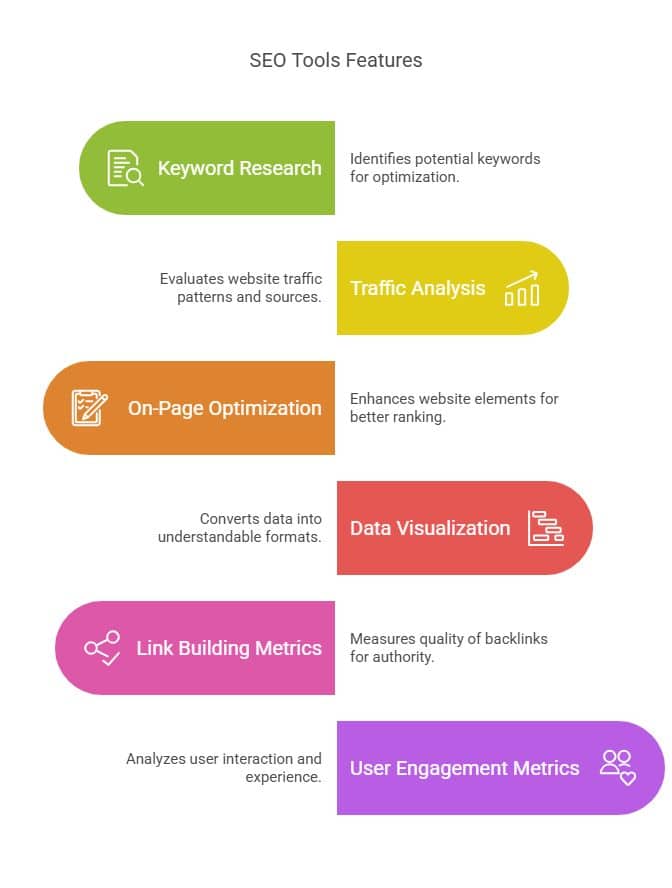
What Are the Basics of SEO Tools and Metrics?
Tools that help with search engine optimization are essential for making websites more visible & improving their performance online. These tools vary from full-featured packages to specialized applications focused on specific tasks such as researching keywords or analyzing website traffic. Key metrics such as search volume, keyword difficulty, and click-through rates help measure a site’s effectiveness in attracting and engaging users. Strategies for improving website visibility and credibility involve enhancing content quality and acquiring links from other sites. Monitoring SEO performance involves analyzing organic traffic trends, user engagement, and backlink quality. As SEO evolves, focusing on user experience, mobile optimization, and analytics is crucial. Explore further to enhance your SEO strategy.
Key Takeaways
- SEO tools offer functionalities like keyword research, traffic analysis, and on-page optimization to enhance website performance.
- Keyword metrics, such as search volume and difficulty, guide strategy by indicating potential traffic and ranking challenges.
- Data visualization in SEO tools transforms complex data into clear, actionable insights for improved decision-making.
- Link building metrics assess backlink quality, impacting site authority and organic search rankings.
- User engagement metrics, including bounce rate and session duration, provide insights into website user experience and effectiveness.

Understanding SEO Tools

The landscape of search engine optimization (SEO) is vast, and understanding SEO tools is a critical component for navigating it effectively. SEO tools have different kinds. Each tool serves a special purpose to improve online visibility & performance. Some tools offer many functions. Other tools focus on specific tasks. Choosing the correct SEO tool types is important for getting the best efficiency and results.
In today’s data-driven environment, user experience is paramount. SEO tools must offer intuitive interfaces that streamline workflows and facilitate seamless navigation. A software designed with user-friendliness in mind makes it easier to learn & use boosting efficiency.
Additionally, data visualization plays a pivotal role in transforming complex data sets into digestible insights. Tools equipped with robust data visualization capabilities enable users to easily identify trends, track progress, and make data-informed decisions.
Furthermore, the ability to integrate with other platforms is a sought-after feature in any SEO tool. Integration capabilities allow for the smooth interaction between different software systems, enabling a cohesive and unified approach to SEO strategy. This seamless integration can save time and resources while maintaining data consistency across various platforms.
Automation features are also indispensable in modern SEO tools. By automating repetitive tasks, such as reporting and monitoring, these features free up valuable time, allowing SEO professionals to focus on strategic decision-making and creative problem-solving.
Ultimately, understanding the diverse range of SEO tools and their capabilities is essential for anyone looking to optimize their online presence effectively.
Keyword Research Essentials

Keyword research is a cornerstone of successful search engine optimization, directly influencing a website’s visibility and relevance. It involves identifying specific terms and phrases that potential visitors use when searching for information, products, or services. A well-executed keyword strategy ensures alignment with user needs and search engine algorithms, enhancing a site’s performance.
Central to this process is understanding search intent, which indicates the purpose behind a user’s query. Whether informational, navigational, or transactional, recognizing search intent allows marketers to tailor content that meets user expectations effectively. This understanding aids in selecting not only popular keywords but also long tail keywords. These are longer, more specific phrases with lower search volume but often higher conversion rates due to their precision in addressing niche markets.
Another critical element is assessing keyword difficulty, a metric that measures how challenging it is to rank for a particular keyword. Factors influencing keyword difficulty include competition level and the authority of existing pages ranking for the term. By focusing on keywords with manageable difficulty, businesses can optimize their resources and improve their ranking prospects.
The text rewritten with a normal vocabulary, few commas and a low degree of burstiness using only the English language, is as follows: Seasonal patterns significantly impact keyword research. They show how user interest changes during the year. Businesses can benefit from creating content that matches these patterns. This allows them to take advantage of times when interest is highest. As a result, they can attract more website visitors and engagement.
Analyzing Website Traffic

Understanding website traffic is crucial for evaluating the effectiveness of an SEO strategy. Analyzing website traffic provides valuable insights into how visitors interact with your site, highlighting areas for potential enhancement. One of the primary elements of this analysis is identifying traffic sources. By understanding where visitors are coming from—whether through organic search, direct visits, social media, or referrals—businesses can tailor their SEO efforts accordingly to enhance visibility and reach.
Examining user behavior further enriches this analysis. It involves observing how visitors navigate through the site, which pages attract the most attention, and the duration of their stay. This information is pivotal for optimizing content and site structure to better meet user needs.
Additionally, monitoring bounce rates—indicating the percentage of visitors who leave after viewing only one page—can reveal the effectiveness of landing pages and highlight if content meets visitor expectations.
Conversion tracking is another essential metric in analyzing website traffic. By setting up goals and tracking conversions, businesses can quantify the success of their SEO strategies in terms of lead generation, sales, or other desired outcomes. This metric helps in understanding which traffic sources and user interactions are most effective in achieving business objectives.
Lastly, audience segmentation allows for a more granular analysis of website traffic. By categorizing visitors based on demographics, location, and behavior patterns, businesses can develop targeted strategies that resonate with specific segments. This segmentation ensures that SEO efforts are not only broad-reaching but also precisely targeted, enhancing overall engagement and conversion rates.
Competitor Analysis Techniques

When developing an effective SEO strategy, examining competitor analysis techniques is invaluable. Understanding how competitors achieve their digital presence assists in identifying opportunities and potential pitfalls.
One crucial component is backlink analysis. By examining the types of backlinks competitors attract, a business can discern which sources are most beneficial for enhancing authority and visibility in search engines. Analyzing these backlinks offers insights into the quality and relevance of linking domains, guiding similar link-building efforts.
Another essential technique is identifying content gaps. This involves scrutinizing competitor content to find topics or keywords they cover extensively while your website does not. Addressing these content gaps can increase the comprehensiveness of your site, attracting a broader audience and improving search rankings.
Social signals, such as likes, shares, and comments on social media platforms, are also worth observing. These signals often correlate with higher rankings, as they reflect content popularity and engagement levels. By analyzing competitors’ social signals, businesses can refine their content and promotional strategies to enhance online visibility.
Additionally, understanding traffic sources is critical. Competitor analysis tools can reveal where a competitor’s traffic originates, whether from organic search, paid ads, or social media. This helps in tailoring marketing efforts to capitalize on similar channels.
Lastly, consider SERP features—elements like featured snippets and local packs that appear on search engine results pages. Analyzing which SERP features competitors rank for can inform content strategies to target these valuable positions, ultimately driving more organic traffic.
Each of these techniques collectively aids in fortifying an SEO strategy against competitors.
On-Page SEO Tools

On-page SEO tools frequently play a pivotal role in optimizing individual web pages to achieve higher search engine rankings and attract more relevant traffic. These tools focus on various aspects that directly influence a webpage’s visibility and performance, making them indispensable for comprehensive on page optimization. They help identify areas of improvement and provide actionable insights to enhance content quality, optimize meta tags, and improve internal linking structures.
- Content Quality Enhancement: On-page SEO tools analyze the content of a webpage to ensure it is relevant, engaging, and informative. They assess keyword usage, readability, and overall structure, guiding content creators in delivering material that meets both user expectations and search engine requirements.
High-quality content is a cornerstone of effective on page optimization, as it directly impacts user engagement and search rankings.
- Meta Tags Optimization: Tools designed for on-page SEO often include features for examining and refining meta tags, such as title tags and meta descriptions. Properly optimized meta tags are crucial as they serve as a webpage’s advertisement in search engine results, impacting click-through rates and visibility.
These tools help ensure that meta tags are not only keyword-rich but also compelling and relevant to the page’s content.
- Internal Linking and User Experience: Effective internal linking is another critical area addressed by on-page SEO tools. By suggesting optimal link placements, these tools enhance navigation and ensure a seamless user experience.
A well-structured internal linking strategy not only aids in distributing page authority but also keeps users engaged, reducing bounce rates and encouraging deeper site exploration.
Incorporating these elements into your on-page SEO strategy can significantly improve a website’s search engine performance and user satisfaction.
Off-Page SEO Strategies

Off-page SEO strategies encompass a set of techniques focused on enhancing a website’s authority and reputation beyond its own pages, primarily through external link building, social media engagement, and brand mentions. These strategies are vital for increasing a site’s visibility and ranking in search engine results. A prominent component is link building, which involves acquiring backlinks from reputable sites to boost credibility. Effective link building can be achieved through guest blogging, where content is created for other sites in exchange for a backlink, thereby expanding reach and authority.
Social media platforms play a crucial role in off-page SEO by amplifying content visibility and fostering engagement. Sharing content on social media can lead to increased brand mentions, further signaling relevance to search engines. Additionally, influencer outreach can be a powerful approach, as influencers have the capacity to reach wide audiences, thereby enhancing brand exposure and generating high-quality backlinks.
Content marketing remains a cornerstone of off-page SEO. By producing valuable, shareable content, businesses can organically attract links and mentions from various online platforms. The following table encapsulates key off-page SEO strategies:
| Strategy | Description | Benefit |
| Link Building | Acquiring backlinks from reputable sites | Boosts site credibility |
| Social Media | Sharing content on platforms to increase visibility | Enhances brand exposure |
| Guest Blogging | Writing articles for other sites in exchange for a link | Expands reach and authority |
| Influencer Outreach | Partnering with influencers to promote content | Reaches wide audiences |
Measuring SEO Performance
Measuring SEO performance is crucial for understanding the effectiveness of optimization strategies and for making data-driven decisions. By analyzing various SEO performance indicators, businesses can determine which areas need improvement and which strategies are yielding positive results.
Here are three key aspects to consider when evaluating SEO performance:
- Organic Traffic Trends: Monitoring organic traffic trends is essential for assessing the overall reach of a website. By examining changes in organic traffic over time, it becomes possible to identify patterns and determine the impact of recent SEO efforts. A noticeable increase in organic traffic suggests improved visibility and effectiveness in attracting potential customers.
- Ranking Fluctuations Analysis: Analyzing ranking fluctuations helps in understanding how a website’s position in search engine results pages (SERPs) changes over time. This analysis provides insights into the website’s performance against competitors and helps identify keywords or pages that require optimization. Regularly tracking these fluctuations is pivotal for adapting strategies to maintain or improve rankings.
- Backlink Quality Assessment and User Engagement Metrics: Assessing the quality of backlinks is vital for determining the strength of a website’s link profile. High-quality backlinks from reputable sources can significantly enhance a website’s authority and credibility.
Additionally, measuring user engagement metrics, such as bounce rate, average session duration, and pages per session, offers insights into the user experience and content relevance. These metrics help in identifying areas for improvement to boost user satisfaction and retention.
Key SEO Metrics

Understanding key SEO metrics is fundamental to evaluating the success and efficiency of search engine optimization efforts. These metrics provide invaluable insights into various aspects of SEO, enabling marketers to make informed decisions and strategize effectively.
Among the essential metrics, search volume stands out as an indicator of how often a keyword is searched, providing a glimpse into potential traffic and audience interest. A higher search volume often signifies a greater opportunity for attracting visitors, but it must be balanced with the keyword difficulty, which assesses how challenging it is to rank for that keyword. Keywords with low difficulty and high search volume are ideal targets for optimization.
Another crucial metric is click-through rate (CTR), which measures the percentage of users who click on a search result after seeing it. A high CTR suggests that the listing is compelling and relevant to the audience, while a low rate may indicate a need for improved meta descriptions or titles. Organic rankings, or where a webpage appears in search results without paid promotion, are directly influenced by the quality of these elements and overall SEO strategy.
Backlink quality is also pivotal. High-quality backlinks from reputable sites can significantly enhance a site’s authority and credibility, positively impacting organic rankings. However, not all backlinks are created equal; those from dubious sources can harm rather than help SEO efforts.
Incorporating these metrics into regular analysis allows for the refinement of tactics and the achievement of long-term SEO goals, ensuring a competitive edge in the digital landscape.
Improving Site Rankings
Optimizing site rankings demands a strategic approach that encompasses both on-page and off-page elements. To achieve this, webmasters must focus on several key areas that influence search engine results. Understanding these components will help enhance your site’s visibility and appeal to both users and search engines.
- Content Optimization: The foundation of SEO lies in creating high-quality, relevant content that addresses the needs of your audience. Effective content optimization includes the use of targeted keywords, meta tags, and headers to improve relevance.
Regularly updating content ensures it remains fresh and engaging, thereby improving your site’s credibility and ranking potential.
- Technical SEO and Mobile Optimization: A website’s technical foundation is critical for search engines to crawl and index pages efficiently. Technical SEO involves optimizing site speed, ensuring secure connections (HTTPS), and fixing broken links.
With mobile optimization, ensuring that your website is responsive and provides a seamless experience across all devices is crucial, given the growing number of mobile users. A mobile-friendly site enhances user experience, which is a significant ranking factor.
- Link Building and User Experience: Establishing a robust link building strategy is essential for improving site authority. Quality backlinks from reputable sites signal to search engines that your content is credible and valuable.
Additionally, focusing on user experience, such as intuitive navigation and fast-loading pages, can reduce bounce rates and increase dwell time, both of which positively impact rankings.
Future SEO Trends

Amidst the ever-evolving digital landscape, future SEO trends are poised to reshape how businesses approach online visibility. As technology progresses, leveraging voice search is becoming essential for enhancing search engine optimization. With the proliferation of smart speakers and voice-activated assistants, optimizing content for natural language queries will be critical to capturing voice-driven traffic. This shift necessitates a focus on conversational keywords and long-tail phrases that align with how users speak.
Simultaneously, mobile optimization continues to gain prominence. As mobile devices dominate web traffic, ensuring websites are mobile-friendly is paramount. This involves responsive design, fast load times, and intuitive navigation to improve user experience. Google’s mobile-first indexing underscores the importance of this trend, demanding that businesses prioritize mobile versions of their sites.
Artificial intelligence (AI) is also revolutionizing SEO practices. AI algorithms are increasingly influencing search engine operations, enabling more personalized and relevant search results. By analyzing user behavior and preferences, AI can refine content recommendations, enhancing user engagement and satisfaction.
Moreover, user experience remains at the heart of SEO strategies. Search engines prioritize sites that deliver seamless, valuable interactions, rewarding those that cater to user needs effectively. This entails optimizing page speed, ensuring accessibility, and crafting high-quality content that resonates with audiences.
Lastly, local SEO is gaining traction as consumers seek geographically relevant information. With the rise of “near me” searches, businesses must optimize for local search terms and maintain accurate business listings to capture local traffic.
Embracing these emerging trends will be crucial for businesses striving to maintain a competitive edge in the digital realm.
Final Thoughts
Understanding and utilizing SEO tools and metrics are essential steps toward enhancing online visibility and achieving long-term success in search rankings. From foundational practices like keyword research and content optimization to advanced tactics like competitor analysis and mobile optimization, these strategies work together to improve a site’s authority, user experience, and relevance in search engines. As SEO continues to evolve, staying updated with emerging trends such as voice search, AI integration, and local SEO can further refine your approach, keeping your site competitive and impactful in a dynamic digital landscape.
Ready to elevate your website’s search visibility and achieve lasting success online? Connect with Syville Gacutan, an experienced SEO Specialist in the Philippines, for personalized SEO strategies and expert guidance. Let’s optimize your online presence—reach out today!